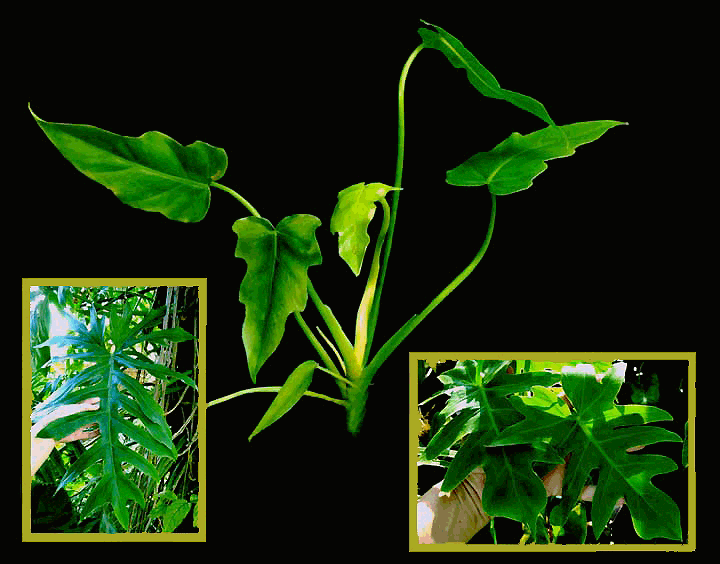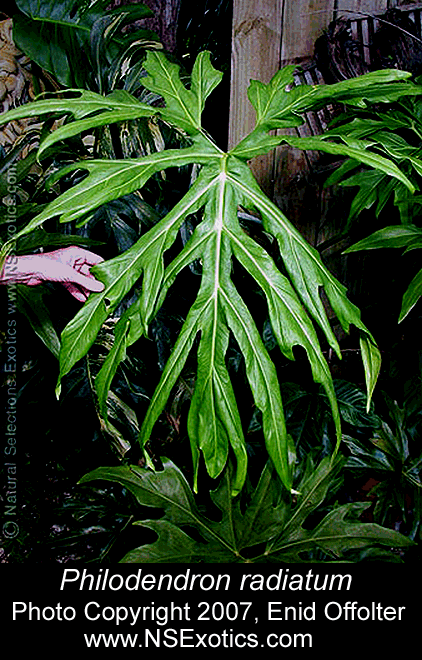![]()
Aroids and other genera in the Collection
Take the Tour Now?
Orchids
The
Exotic Rainforest
Plants in
the Exotic Rainforest Collection
Images on this website are copyright protected. Contact
us before attempting to reuse.
In depth information on how to grow
Philodendron
species, Click this Link
This link will show you all the Aroids and other genera in the Collection
Philodendron radiatum
Schott
Synonym: Philodendron impolitum
Sometimes sold as "Philodendron barryii"

Philodendron
radiatum
Schott
Synonym:
Philodendron impolitum
Sometimes sold with the misnomer "Philodendron barryii"
Sometimes sold with the misnomer "Philodendron barryii"
Philodendron species are
known to be highly variable and not every leaf of every specimen
will always appear the same. In addition, Philodendron
species go through a morphogenesis as they grow and change their
appearance from juvenile through adult in the same way children
morph as they grow. This link explains in greater
detail the scientific principle of natural variation and
morphogenesis.
Click
here. Understanding
morphogenesis and natural species variation will help you to
understand the problem encountered by the seller in this text.
Philodendron
radiatum is found in the Chiapas region of tropical Mexico
down through Central America and on into most of the
northwestern portion of South America down through Peru.
It is also grows in portions of Brazil. According to
scientific texts the
plant is an epiphyte (ep-a-FIT) growing upon other plants (normally a tree)
and is a vigorous climber that can reach a leaf size of up to
90cm (3 feet) under ideal conditions and is deeply pinnatifid
(incised and lobed) with 5 to 10 lobe segments on each side of
the leaf blade. However, Philodendron radiatum has
been observed growing on the ground as well as on stone.
Since
Philodendron radiatum is highly variable and takes on many
forms apparently someone felt one of the numerous
 intermediate growth
forms of the plant deserved a totally new name so they tried to give it
the misnomer "Philodendron barryii". Perhaps it was someone
named Barry who just wanted a plant named after himself!
This is a scientifically name species known as
Monstera barrieri , but there is no such scientific name as "Philodendron barryii"!
intermediate growth
forms of the plant deserved a totally new name so they tried to give it
the misnomer "Philodendron barryii". Perhaps it was someone
named Barry who just wanted a plant named after himself!
This is a scientifically name species known as
Monstera barrieri , but there is no such scientific name as "Philodendron barryii"!
 intermediate growth
forms of the plant deserved a totally new name so they tried to give it
the misnomer "Philodendron barryii". Perhaps it was someone
named Barry who just wanted a plant named after himself!
This is a scientifically name species known as
Monstera barrieri , but there is no such scientific name as "Philodendron barryii"!
intermediate growth
forms of the plant deserved a totally new name so they tried to give it
the misnomer "Philodendron barryii". Perhaps it was someone
named Barry who just wanted a plant named after himself!
This is a scientifically name species known as
Monstera barrieri , but there is no such scientific name as "Philodendron barryii"!
The
science of naming a plant is technical and requires a
lengthy process which verifies scientifically many
factors including the plant has not previously been identified.
One other scientist attempted to name this species
Philodendron impolitum, but that name is now considered
simply a synonym of Philodendron radiatum. Obviously, whoever knighted this one "Philodendron barryii"
had neither a scientific background nor did their homework.
To be officially named a plant must be published by a recognized
botanical scientist in a scientific journal. Philodendron radiatum
was identified scientifically in 1853 but I have no idea when
someone attempted to give it the name "barryii".
It may be understandable someone thought they had a new species
since Philodendron radiatum has many growth forms.
At least ten variations have been observed in Mexico,
Central America, Venezuela, Colombia, Ecuador, Peru, parts of
Brazil and a few Caribbean islands.
In 2004 I
found this interesting multi-lobed plant being sold on eBay as
Philodendron "barryii". Botanist
Dr. Tom Croat's journal on Central American Philodendron sp.
does not list that name. The text Aroids, Plants of the Arum
Family does not recognize "P. barryii", as do none of the
recognized resources such as the International Plant Names Index, TROPICOS
(a service of the Missouri Botanical
Garden), GRIN, ePIC or the Royal Botanic Garden Kew in London. Not one major botanical collection recognizes the name.
The
seller informed me that "P. barryii" was the name she had known
it by for years and another collector had assured her the name
was scientific. She insisted the plant was very rare
and was new to science. So
"rare", apparently no recognized botanist even knew it existed! I could not find
any technical information! None! But she also said she sold a
lot of them. A "lot of plants" and "rare" are two terms that
do not fit well together in my understanding of truly rare
plant species. So I sent the photo of "P. barryii" to several
botanists and knowledgeable collectors. None had ever heard of
"P. barryii". The chase to find out what the plant
actually was known in science had begun.
One very
knowledgeable scientist said although he did not recognize the
photo he felt it was likely a relative of Philodendron
bipinnatifidum which is often sold as Philodendron selloum
(P. selloum is no longer a recognized botanical name). He
reached that conclusion due to the multiple lobes of the
species. He had never heard the name "P. barryii".
Another knowledgeable botanist who works for the State of
Florida thought it could be a variety or
throwback of P. xanadu (see that species on this site).
The seller said the plant grew
like a vine. So I set out to learn about Philodendron sp. that
have multiple incised lobes and produce vines. That narrowed
the search down to Philodendron pedatum, Philodendron
laciniatum, Philodendron quercifolium,
(for more information on those species
click this link) Philodendron radiatum and quite a few others. One well known rare
collector had an identical photo of the plant
offered for sale on eBay on his website noted as Philodendron
quercifolium but told me the plant was probably P.
pedatum. He also noted that plant vines. Although they
don't look exactly alike most botanists consider the first three
listed to be the same species, just synonyms (same plant, other name).
Like many Philodendron sp., these are variable and take
on multiple blade forms. And when I uncovered a photograph
of Philodendron pedatum on a scientific site it looked
nothing like "Philodendron barryii". Or Philodendron
radiatum! (You can find Philodendron pedatum on
this website, just check "Aroids and other genera in the Collection") But
one grower who had the only photo of the plant I could
locate on the internet listed as "P. barryii" told me he was certain "barryii"
was a misnomer. With the help of recognized aroid botanist
Dr. Croat of the Missouri Botanical Garden, he was
certain his aroid was actually Philodendron radiatum.
After a great deal
of searching, an expert retail grower who I trust told me they
also knew the plant as Philodendron radiatum. Finally,
two collector/growers and one botanist with the same conclusion! I was also told
by the second grower they had it growing all over a large tree
and it certainly was not rare but was in fact a climbing vine!
The chase was about to end.
In the meantime the original eBay
seller was quite certain the species was truly "Philodendron barryii".
It was her belief the plant was was so rare no botanist even knew it
existed! That would be a miracle since recognized botanists are
the scientists who give plants their names! If it truly had a name, it had
to be a published species. Otherwise that name was simply
a "common name"! And common names have no bearing in
science. That meant some botanist somewhere
had to have described it to science or the name was invalid.
And for certain that published
name would be recorded in one of the recognized databases.
During my reading I came across an interesting quote. This
quote from page 213 of the book Aroids, Plants of the
Arum Family resolves the dilemma:
"Philodendron seedlings have
heart shaped leaves, but subsequent growth may go through a
succession of leaf sizes and shapes until the final adult stage
is reached. Philodendron radiatum is a good example,
beginning with entire blades and becoming increasingly incised
so that mature foliage is pinnatifid (cut almost to the
midrib)."
finally, an explanation!
I had already observed the changes
in Philodendron species as they grew in my own atrium. What the
the text was saying was the plant changes dramatically as it grows
from a juvenile with an oval blade to a plant with multiply
incised lobes. Every step along the way produces what appears
to be a new plant species! Philodendron radiatum has many
different shapes!
According to the
scientific text published by
botanist Heinrich Wilhelm Schott, there are variations of
P. radiatum,
"Philodendron radiatum has
variations, the typical variety having more deeply
divided leaf blades with the segments often incised almost to
the midrib and P. radiatum var. pseudoradiatum with the
blades only weakly incised-lobate (less than half the distance
to the midrib)."
Most Philodendron
sp. have variations, we tend to collect and grow only the
ones we consider the most beautiful. And the misnomer "barryii" is nothing more than a
pre-adult form of Philodendron radiatum. "P.
barryii" is not a species!
All Philodendron species are aroids. An aroid is a plant
that reproduces by growing an inflorescence known to science
as a spathe and spadix. Some believe the spathe is a
"flower" which is incorrect. The spathe is simply a
modified leaf
appearing to be a hood
and is sometimes shaped like a
tube. When an aroid is referred to as "flowering" the
reference is to the very small flowers found on the spadix
and the term has nothing to do with the spathe. Within the
inflorescence there are extremely small flowers found on the
spadix during anthesis (sexual reproduction). The
spadix is found at the center of the inflorescence.
When ready to reproduce, the spadix produces both male,
female and sterile flowers and if the female flowers
are pollinated with pollen brought by an appropriate insect
(normally a beetle from the genus Cyclocephala) from another plant which is at male
anthesis they will produce berries containing seeds.
The spathe and spadix (inflorescence) of Philodendron
radiatum measures 20 to 26cm (8 to 10 inches) in size.
The spathe tube is green and is heavily tinged with red while
the inside is dark purple-violet.
Being a rain forest plant if
you are growing this species use good soil mixed with peat,
Perlite™ and orchid bark
added for good drainage. The soil should be
kept damp but not soggy.
The inset photos
above of an intermediate
(right) and adult growth form (left) were provided by Natural
Selections Exotics in Fort Lauderdale. The main photo is
the plant sold as "Philodendron barryii".
Want to learn more
about aroids?
Join the International Aroid Society: http://www.exoticrainforest.com/Join%20IAS.html
Join the International Aroid Society: http://www.exoticrainforest.com/Join%20IAS.html